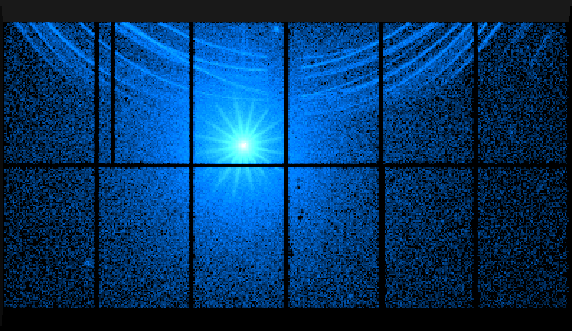Next: 3.3 EUROPEAN PHOTON IMAGING CAMERA (EPIC) Up: 3.2 X-ray Telescopes Previous: 3.2.3 Response matrices used in the SAS data analysis
The third important performance characteristic of the X-ray telescope, as listed above, is the efficiency of the straylight rejection.
X-ray straylight in EPIC is produced by rays which are singly reflected by the mirror hyperbolas and which reach the sensitive area of the camera. An X-ray baffle was implemented to shadow those singly reflected rays. It consists of two sieve plates made of concentric annular aperture stops located in front of the mirrors at 85 mm and 145 mm, respectively. The design is such that the entrance annular aperture of each mirror remains unobstructed for on-axis rays. Most of the rays with large off-axis angle are vignetted and cannot reach the detectors anymore via a single hyperbola reflection.
The straylight collecting area in the EPIC detector as a function of
off-axis angle for a point source is about 3 cm for stray sources located between
for stray sources located between  and
and  from the optical
axis. At higher off-axis angles it is completely negligible. The ratio of
the X-ray straylight collecting area to the on-axis effective area is
smaller than 0.2% at 1.5 keV for a point source located at off-axis
angles of 0.4-1.4
from the optical
axis. At higher off-axis angles it is completely negligible. The ratio of
the X-ray straylight collecting area to the on-axis effective area is
smaller than 0.2% at 1.5 keV for a point source located at off-axis
angles of 0.4-1.4 and negligible at higher off-axis angles.
This ratio, expressed in surface brightness values, is even smaller
since the stray-image is unfocused at the detector position.
and negligible at higher off-axis angles.
This ratio, expressed in surface brightness values, is even smaller
since the stray-image is unfocused at the detector position.
Assuming a 10 counts/s source, for EPIC MOS on-axis observations half
of the incoming photon flux is distributed over about 150 pixels
(adopting a  HEW), with a central peak. The light of the
same source, observed at a large off-axis angle, is distributed over
about 1/4 or 1/5 of the total EPIC FOV (of order
HEW), with a central peak. The light of the
same source, observed at a large off-axis angle, is distributed over
about 1/4 or 1/5 of the total EPIC FOV (of order  pixels),
leading to a mean count rate of
pixels),
leading to a mean count rate of  counts s
counts s pixel
pixel of diffuse straylight. However, this is only a rough
approximation, because the stray radiation due to an off-axis point
source is not uniformly distributed in the EPIC FOV, but produces
near-annular structures in the image, as for example seen in
Fig. 15.
of diffuse straylight. However, this is only a rough
approximation, because the stray radiation due to an off-axis point
source is not uniformly distributed in the EPIC FOV, but produces
near-annular structures in the image, as for example seen in
Fig. 15.
 |
This illustrates the high straylight rejection efficiency of the XMM-Newton mirror modules. EPIC observations of isolated sources and RGS spectra are hardly affected. For bright extended sources (which are larger than the EPIC FOV, such as some supernova remnants, clusters of galaxies, stellar clusters and star forming regions), on the contrary, there might be a degradation in the ability to perform spatially resolved spectroscopy.
These limitations could play a role in the consideration of
proposing observations of targets that are located within
 of a bright X-ray source, or in cases when imaging
an extended object that is larger than the EPIC
of a bright X-ray source, or in cases when imaging
an extended object that is larger than the EPIC  FOV.
Whether or not straylight is an issue depends largely on the
scientific objectives and on the ratio of the flux of the off-axis
source and the required minimum detectable source flux within the FOV.
FOV.
Whether or not straylight is an issue depends largely on the
scientific objectives and on the ratio of the flux of the off-axis
source and the required minimum detectable source flux within the FOV.
Further information on the XMM-Newton EPIC straylight (which in fact is one of the background components listed in a summarising table available from the Background Analysis page or directly at http://www.cosmos.esa.int/web/xmm-newton/background) can be obtained from an on-line presentation at http://www2.le.ac.uk/departments/physics/research/src/Missions/xmm-newton/technical/mpe-2006-05/MFreyberg_slewcal.pdf.
European Space Agency - XMM-Newton Science Operations Centre